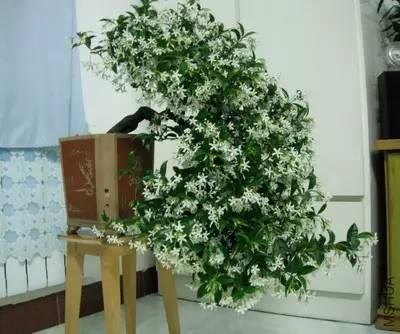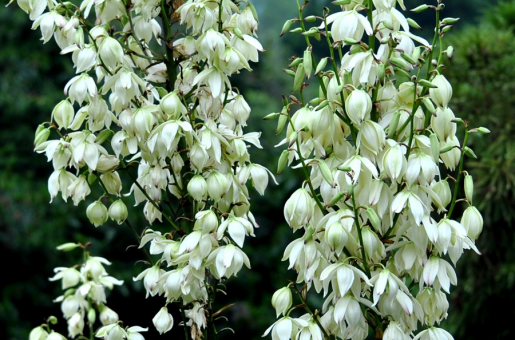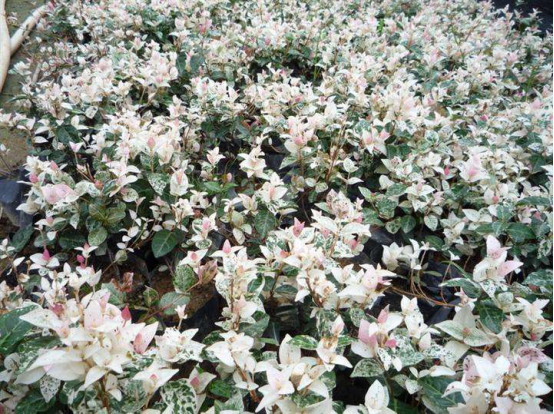II. Maintenance of Constellation bonsai
Flowers such as snow, beautiful branches and leaves, beautiful Luoshi bonsai in addition to have a better pruning method, we should also pay attention to its maintenance methods. Reasonable maintenance is not only a necessary condition for better growth, but also the basis for pruning the most beautiful Luoshi bonsai.
1. The right temperature and light
Luoshi bonsai, as a temperate flower, likes warmth and light source, but must avoid direct glare. We can put it in a sunny place, preferably in a place where we can not only get sunlight, but also avoid direct glare.
two。 Moist soil is also important.
We can water to keep the soil moist, and often spray water on brackets or bonsai to increase moisture. But be sure not to get too waterlogged, or it will affect the normal growth of Luoshi.

The flowers and leaves of Luoshi bonsai bring us no ordinary visual enjoyment. In order to make it more wild and grow freely and vigorously, it is very important to choose the most appropriate pruning method. The above are the main ways to trim the bonsai. Have you learned it?
How to make Shui Pei Luo Shi bonsai? Guide for the maintenance of Shuipeluo stone bonsai
Luoshi, also known as Nadong, Shilongteng, million-zigzag flower, ten-thousand-word jasmine, is an evergreen woody vine, native to Shandong, Shanxi, Jiangxi, Hebei, Henan, Jiangsu and other places in China. It is often used in gardens or potted ornamental plants. Of course, Luoshi not only is used for ornamental purposes, but also has medicinal value. Its roots, stems, leaves and fruits are used for medicinal purposes. It has the efficacy of expelling wind and activating collaterals, promoting joints, stopping bleeding, relieving pain and detumescence, clearing heat and detoxification. It should be noted that Luoshi is a poisonous plant, and its toxicity is toxic to the whole plant. Of course, what we want to talk about today is the production method and maintenance guide of Shuipeluo stone bonsai, as follows.
I. hydroponic method
(1) method 1: cut off the sturdy branches with aerial roots, insert the branches directly into a transparent container, and then add 1/3 of the water that immerses the roots, and water bacon can grow after about 10 days.
(2) method 2: select the sturdy and shaped soil stone, dig out the whole stone plant, rinse it clean and plant it in a transparent container, then add 2/3 of the water that immerses the root system.
(3) method 2: dig the rooted vine around the neck of the root of Tupelo stone, wash the vine and plant it in a transparent container, then add 2/3 water that immerses the root system.
Which method you choose depends on your actual situation, but no matter which method you choose, you have to change the water every 2-5 days.
II. Maintenance guidelines
When Luoshi grows into hydrobacon, it should be cultured in a comprehensive nutrient solution, and the nutrient solution should be changed every 30-60 days, and during this time, the Luoshi pot should be placed in a place with bright scattered light. Avoid direct sunlight in summer and do a good job of shading. When the weather is dry, it is necessary to spray and replenish water to the foliar surface of the collaterals, and in the cold winter season, it should be moved to the indoor for sunny cultivation. Because of its cold resistance, it can survive the winter safely indoors, and appropriate pruning should be carried out for old and over-long branches, which is beneficial to promote the development of new branches and increase the number of flowers.
Production of Luoshi bonsai
It takes skill to cultivate plants, and it takes more skill to make bonsai. After all, making bonsai is a technical task, if you do not master the skills of making bonsai, then it is very difficult to make a beautiful bonsai. The bonsai of different plants have different production methods, the slightest mistake may "destroy" the bonsai, not to mention whether it looks good or not. Just as you have to prescribe the right medicine to treat diseases, making different kinds of bonsai also requires unique skills. Here, the editor wants to show you how to make Luoshi bonsai.
Material selection and cultivation measures
[artificial propagation]: sowing, striping, cutting and other methods can be used. The seeds were sown and collected in early December and dried in the sun to crack the fruit. The seeds were taken out and stored in secret. The seeds were sown from February to March in the following spring. The row spacing of strip sowing is 1520 cm, and the thickness of covering soil is about 1 cm. It can be sprouted and unearthed in the middle and late May. When there are two true leaves in the seedlings, the seedlings can be divided into one time, and the management can be strengthened, and the shading can be set up, and the seedling rate can reach about 70%.
The cuttings were carried out in the rainy season, with half-ripe twigs as cuttings, cut into 8-12 cm long, with 3-4 nodes, 2-3 pairs of leaves in the upper part, deep 1B2, solid soil, full watering, shading, keeping the bed soil moist, and rooting after about 20 days, with a high survival rate. Striping propagation can be done with dormant branches from February to March in spring, or semi-ripe branches with a depth of 3 cm in the rainy season, and can be cut off from the mother plant in August to September for transplantation.
[mountain mining]: Luoshi is very wild in the mountains. Old root piles can be selected. After digging, the stems are cut off and planted in the basin. After the new branches and stems are sprouted, they can be processed and shaped, climbing and winding with stones, or soft branches, and beautiful bonsai in shape.
Pot-up process
Select basin: Luoshi should use deeper glazed pottery basin or purple sand pottery basin, the common ones are thousand-barrel basin and medium-deep square or round basin.
Using soil: Luoshi prefers sandy loam with loose and good drainage. Potted plants should be cultivated with humus soil or mature pastoral soil mixed with sandy soil, and the bottom of the pot should be padded with vermiculite to facilitate water penetration.
Planting: it should be put on the pot in spring, or in autumn. You'd better bring a dirt ball to transplant.
Pose shaping technique
Processing: Luoshi processing modeling, you can first properly climb the main branches, and then combined with pruning, cut off too dense or too long branches to maintain a certain skeleton posture. Climbing should be carried out in summer, when the branches are tender and plastic. Pruning should be carried out during the dormant period to prevent the wound from overflowing milk and affecting growth.
Tree shape: ruoshi trailing, branches drooping, should be made into a drape type, can also be made into stone bonsai. Stone-attached type has two treatment methods: one is to plant the rock in the cave on the top of the rock, and the other is to plant it in the potted soil, equipped with stalagmite, so that it can be wound upward, which is relatively simple and easy.
Maintenance and management
Place: Luoshi bonsai should be placed in a slightly shady place with moist air. Winter can be slightly cold-resistant, transfer to the general indoor can.
Watering: Luoshi likes Yin and dampness, but avoid waterlogging. Usually to keep the basin soil moist, should not be too dry, but also pay attention not to make the basin stagnant water.
Fertilization: during the growth period of spring and summer, organic liquid fertilizer can be often applied, such as rotten cake fertilizer and water.
Pruning: cut off residual branches and withered leaves and overlong and dense vines at any time to maintain a certain shape.
Turn the basin: turn the basin every 2-3 years, preferably before sprouting in spring. Keep the old 1B2 soil and replace it with rich and loose humus and cover the bottom of the basin with coarse sand or vermiculite to facilitate drainage.
Pest control: mainly leaves? For damage, it can be sprayed and killed with trichlorfon or phoxim 800 times.
To sum up, to make Luoshi bonsai, we should first know how to draw materials and cultivate Luoshi, then pay attention to how to do it, and finally know how to shape Luoshi bonsai. In the meantime, special attention must be paid to conservation and management so that Luoshi bonsai can grow in an environment free from diseases and insect pests. I believe that if you make bonsai in accordance with the above methods, you will be able to create a beautiful and elegant Luoshi bonsai!
- Prev

The reason why Phoenix tail orchid does not blossom:
In the north, especially in the northeast and northwest regions, there are a lot of land-planted Cymbidium will appear only leaves do not blossom phenomenon. The reason why Phoenix tail orchid does not blossom has something to do with the climate of these areas and so on. Due to the influence of temperature and other conditions
- Next

The planting method of Luoshi Flower
The main results are as follows: 1. for the selection of basin soil, Luoshi flower can be diversified, and it also has a strong ability to adapt to the requirements of soil. Therefore, there are no fixed requirements and can be chosen according to the preferences of the growers. 2. Light and temperature for light, Luoshi flowers like to grow in sunny places
Related
- Fuxing push coffee new agricultural production and marketing class: lack of small-scale processing plants
- Jujube rice field leisure farm deep ploughing Yilan for five years to create a space for organic food and play
- Nongyu Farm-A trial of organic papaya for brave women with advanced technology
- Four points for attention in the prevention and control of diseases and insect pests of edible fungi
- How to add nutrient solution to Edible Fungi
- Is there any good way to control edible fungus mites?
- Open Inoculation Technology of Edible Fungi
- Is there any clever way to use fertilizer for edible fungus in winter?
- What agents are used to kill the pathogens of edible fungi in the mushroom shed?
- Rapid drying of Edible Fungi

